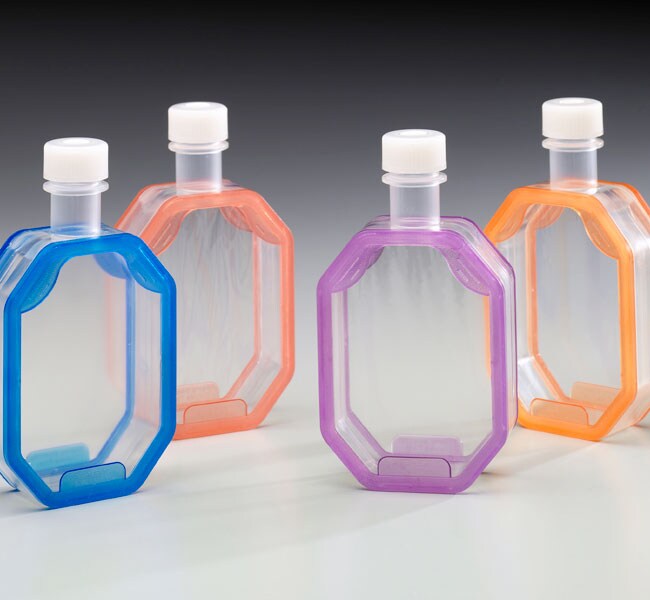Slide-A-Lyzer™ Dialysis Flasks (Thermo Scientific™)
Slide-A-Lyzer Dialysis Flasks (2K, 3.5K, 10K, or 20K MWCO) facilitate simple and effective removal of buffer salts and small contaminants in sample volumes up to 250 mL. They are easy to use: add and remove sample using a serological pipette or by directly pouring the sample through a wide screw-cap opening at the top of the flask. No knots or clips are needed to seal the units. Slide-A-Lyzer Dialysis Flasks are manufactured using clean room conditions and have low-protein binding regenerated cellulose membranes to ensure maximum sample recovery and sample purity.
Key Features
The dialysis flasks are available in distinct colors, corresponding to the pore size (MWCO) of the dialysis membrane: purple (20,000 Daltons), orange (10,000 Daltons), pink (3,500 Daltons), and blue (2,000 Daltons).
Slide-A-Lyzer Dialysis Flasks are constructed from two sheets of low-binding, regenerated-cellulose dialysis membrane that are hermetically sealed on either side of an inert plastic body. The membrane and flask materials are compatible with most laboratory buffers.
Features of Slide-A-Lyzer Dialysis Flasks:
• Easy to use—simply pipette or pour sample into flask and begin dialysis
• Fast dialysis—flat flask chamber with two membranes provides high surface area to volume ratio, enabling dialysis of a 250 mL sample in 8 hours to overnight
• High recovery—rectangular flask design maximizes recovery of entire sample volume via opening at top of flask
• Multiple molecular-weight cut offs—select the membrane MWCO that best suits your sample's molecular weight
Dialysis membrane specifications:
• Composition: regenerated-cellulose
• Thickness: 0.9–1.2 mil (22.5 to 30 μm); 2K MWCO = 2 mil (50 μm)
• Hydration time required before use: 2 minutes
• Glycerol content: trace (10K MWCO content is 21%)
• Sulfur content: 0.04–0.17%
• Heavy metals content: trace
With Slide-A-Lyzer Dialysis Flasks, typical low-molecular weight contaminant removal, buffer exchange, and desalting can be accomplished in eight hours to overnight. The rate of dialysis depends on a variety of factors, including sample volume, size and shape of the molecule being dialyzed, agitation, and temperature. Minimum dialysis time must be determined empirically for each specific system.
Order Codes
| Code |
Description |
| 87760 |
Catalog Number: 87760
Unit Size: 4 flasks
Description: Dialysis Flasks, 2K MWCO |
| 87759 |
Catalog Number: 87759
Unit Size: 6 disks
Description: Dialysis Flotation Disks |
| 87761 |
Catalog Number: 87761
Unit Size: 4 flasks
Description: Dialysis Flasks, 3.5K MWCO |
| 87762 |
Catalog Number: 87762
Unit Size: 4 flasks
Description: Dialysis Flasks, 10K MWCO |
| 87763 |
Catalog Number: 87763
Unit Size: 4 flasks
Description: Dialysis Flasks, 20K MWCO |


